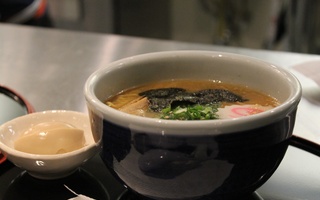{shortcode-dc5ec2df521fc0ec3f0610e78630bad1fb7383cf}
Ramen chefs, poised mere feet away from their customers, are generous stewards of a hallowed, religiously meditative experience—the proper way to eat ramen is to “slurp it up without a word.” The film’s director and narrator, Koki Shigeno, is as much a ramen head as Japan’s most acclaimed chefs and their loyalists. He provides breathy side commentary to orient the audience on its pilgrimage into the kitchen. The notion of simplicity, broached spontaneously by the chefs, serves as a signpost throughout the documentary that genuinely and consistently captures the essence of ramen. The perfect ramen “exists perfectly in the moment and then disappears,” and its impact is in its unceremonious deliciousness. The documentary’s structure is also thankfully contained and to the point: The famed Osamu Tomita and his overarching story allow for easy segues into a diverse pageant of other chef narratives, and a culminating anniversary bit beautifully ties up the film, leaving the audience with a keen nostalgic warmth characteristic of the best ramen. The film’s most obvious flaw is that it becomes aesthetically tiresome and almost indulgently tacky, with constant slow-motion shots of noodles slopping against porcelain bowls, and an especially unsavory history segment that would otherwise have been enlightening if not for visuals that seem inspired by Microsoft Clip Art.
The feat of the chatty Shigeno’s casual recounting is a tell-all spirit that somehow makes intimately familiar a sacrosanct art. All the chefs he features display a monastic devotion to ramen. Tomita’s hole-in-the-wall shop, in the unassuming Matsudo, Chiba Prefecture, is known for producing Japan’s best ramen, available for only eight dollars. Tomita’s ever-changing signature is a muddy, blended broth. Shigeno duly informs the audience of its privilege: Unlike more secretive top-chefs, Tomita shows the camera everything, proof of his self-assurance and his alignment with the democratic spirit of ramen, historically a workingman’s dish. His oil-stained notebook from his own apprentice days is replete with cartoonish diagrams that resemble the machinations of a mad scientist. The ramen bowl derives its perfection from robust fundamentals: It’s not the ingredients that matter, but how the chef uses them. Tomita’s handmade noodles are the result of a painstaking selection process out of hundreds of Japanese flours. He aims for a quality he calls “slurpability,” ensuring that his noodles are longer than most so that his customers can savor their flavor for just the right amount of time. His apprentices, cultish with their toweled heads and matching robes, partake in a shared ritual, tasting from the same bowl at the end of each working day—an ongoing initiation in a deeply traditional yet ceaselessly inventive craft. By the end of the work day, Tomita hasn’t gone to the bathroom even once, soldered in place above his cauldron of boiling broth, entranced.
Shigeno himself heightens the mysticism of ramen devotion, likening one broth to “a witch’s brew from children’s books.” Though Shigeno’s whispered awe provides welcome companionship for the audience, the true essence of the lifetime ramen devotee can be observed in silence, as the camera picks up on the smallest moments in which a normally strict, buttoned-up maestro unwinds. Shigeno allows Tomita such freedom that he’s unguarded before the audience, unabashedly grabbing a stranger’s leftover bowl and draining it on one of his personal field trips to competitor ramen shops. When Shigeno embarks on a brief history segment on the origins of ramen that is visually distracting and bewilderingly ugly, it momentarily cheapens the ramen mystique that he spends the entire film dutifully peddling. Patchy and mismatched visuals aside, he recounts fun ramen lore: In 1947, a cook overslept while preparing broth, resulting in a white cloudy soup that today is known as tonkatsu broth and the basis of Tomita’s famous ramen.
The documentary aptly concludes with the passing of the mantle: Tomita’s young son already evinces the self-flagellating disciplinarian tendencies of his father, grumbling, “I’ll have to get this stupid tongue of mine into shape.” Shigeno successfully imparts his own deep reverence for Tomita’s gift of culinary sensibility, and the artistry behind an unassuming, everyday dish that is not prim and fancy like sushi, but that is a lifelong and messy project as cloudily complex as its broth mixtures. Though it can become tiresome without an avid culinary curiosity, as glamorous cinematic thrills are not the film’s strength, the documentary can be riveting to someone who has even a passing interest in ramen.
Read more in Arts
The Foundations and Dreams of the Technical Theater SceneRecommended Articles
-
The Mail FACTS WRONGTo the Editors of the CRIMSON: It is little wonder that the administration rarely resorts to defending itself with facts,
-
LAMPY DESERTS AUTOS FOR COPS AND MURDERSThe following review of the current issue of the Lampoon is written by Kendall Foss '27, former President of the
-
 Santouka Ramen
Santouka Ramen -
In Downtown Boston, A Tiny Powerhouse of Ramen ArtistryOisa Ramen Slurp & Go may be a tiny restaurant, but it punches way above its weight-class when it comes to flavor.
-
 Community Ramen Hotspot Still the Stuff of Dreams
Community Ramen Hotspot Still the Stuff of Dreams













